
Consider the circuit shown in Figure P2.47. Assume each diode cut−in voltage is
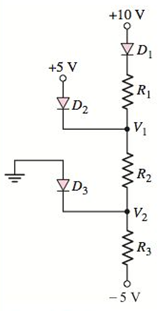
Figure P2.47
(a)
The values of
Answer to Problem 2.47P
The required values are,
Explanation of Solution
Given:
Diode’s cut-in voltage =
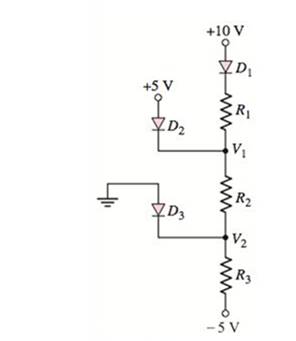
Calculation:
Assume all diode are conducting.
Draw the circuit diagram with node voltages and cut-in voltages.
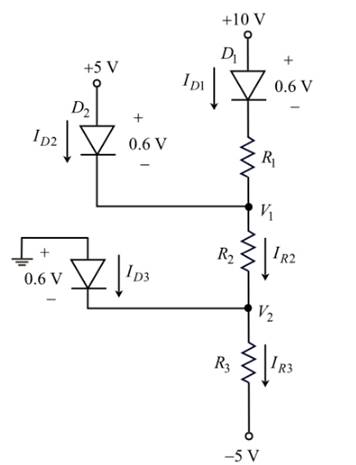
Figure 1
From Figure 1, the voltage at node
The voltage at node
Write the expression for current following through diode
Substitute
Therefore, the value of the resistor,
Apply Kirchhoff’s current law at node
Substitute
Calculate the value of resistor
Substitute
Therefore, the value of the resistor
Apply Kirchhoff’s current law at node
Substitute
Calculate the value of resistor
Substitute
Therefore, the value of the resistor,
Conclusion:
Therefore, the required values are
(b)
To find: The values of
Answer to Problem 2.47P
The required values are,
Explanation of Solution
Given:
Diode’s cut-in volt- age is

Calculation:
Assume at diodes are conducting.
From Figure 1, the voltage at node
The voltage at node
Calculate the current,
Substitute
Therefore, the current following through diode
Calculate the current following through resistor
Substitute
Apply Kirchhoff’s current law at node
Substitute
Therefore, the current following diode
Calculate the current following through resistor,
Substitute
Apply Kirchhoff’s current law at node
Substitute
Therefore, the current following diode
Conclusion:
Therefore, the required values are
(c)
To find: The values of
Answer to Problem 2.47P
The require values are
Explanation of Solution
Given:
Diode’s cut-in volt- age is
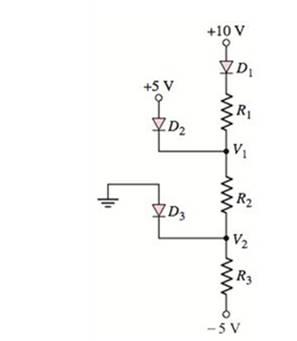
Calculation:
Assume diode
Draw the current diagram with node voltage and cut-in voltages.
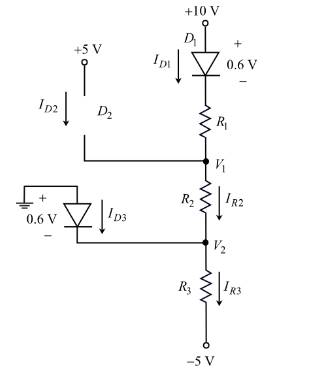
Figure 2
In Figure 2, the Diode
That is,
Therefore, the current following through diode
From Figure 2, the voltage at node
Apply Kirchhoff’s current law at node
Substitute
Calculate the current
Substitute
Therefore, the current following diode
From Figure 2,
Calculate the current following through resistor,
Substitute
Apply Kirchhoff’s current law at node
Substitute
Therefore, the current following diode
(d)
To find: The values of
Answer to Problem 2.47P
The required values are
Explanation of Solution
Given:
Diode’s cut-in volt- age is
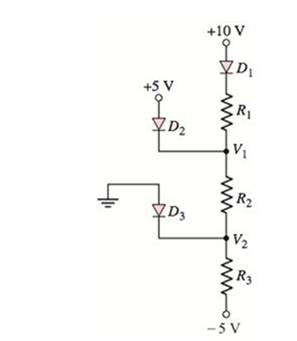
Calculation:
Assume diode
Draw the circuit diagram with node voltages and cut-in voltages.
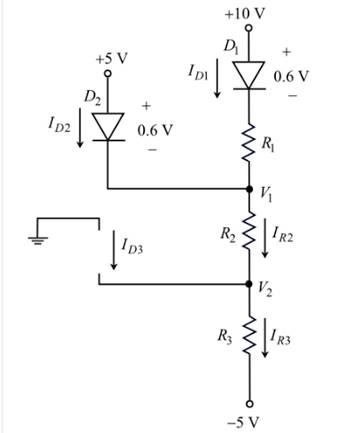
Figure 3
In Figure 3, the Diode
That is,
Therefore, the current following through diode
From Figure 1, the voltage at node
Therefore, the node voltage,
Apply Kirchhoff’s current law at node
Substitute
Calculate the current
Substitute
Therefore, the current following diode
Calculate the current following through resistor,
Substitute
Apply Kirchhoff’s current law at node
Substitute
Want to see more full solutions like this?
Chapter 2 Solutions
Microelectronics: Circuit Analysis and Design
- I need help on this question a) Find y(t) =yh(t) +yp(t) in time domainIs the system over-damped, under-damped, or critical?arrow_forwardGiven f(t)=a sin(ßt) a = 10 & ß = 23 Find the Laplace Transform using the definition F(s) = ∫f(t)e-stdtarrow_forward= Calculate Avf, Zif, and Zof for the amplifier circuit,Assume he = 50, hie 1.1k2, and identical transistors? 150kQ Vs 5002 HH +25v 10k +6 · 47ΚΩ 47k2 4.7k0} 33 ΚΩ 4.7ΚΩ 10k w 4.7kQ HH Voarrow_forward
- For the four-pole filter in Fig. (2), determine the capacitance values required to produce a critical frequency of 2680 Hz if all the resistors in the RC low-pass circuits are 1.8 K. Also select values for the feedback resistors to get a Butterworth response. Note: For a Butterworth response, the damping factor must be 1.848 for the first stage and 0.765 for the second stage. (2) Re Res ww " = 11arrow_forwardFor the circuit shown in Fig. 2.20, the transistors are identica' and have the following parameters: hje=50, hie = 1.1K, hr =0, and hoe = 0. Calculate Auf, Rif and Rof. Ans: 45.4; 112 KN; 129N. HH 150k 47k R 25 V 10k 47k 4.7k 5μF 33k 4.7k 50µF 50µF 4.7k 4.7k R₁ Roj R1000arrow_forwardA triangular wave is applied to the input of Fig. (3). Determine what the output should be and sketch its waveform in relation to the input. 10μs. 0 5μs 15 μs 0.001 μF R₁ w 2.2karrow_forward
- A three-phase, 480-V, 60-Hz, 6-pole, Y-connected induction motor has its speed controlled by slip power. The circuit parameters are given: Rs=0.06 ohms, Rr=0.05 ohms, Xs=0.2 ohms, Xr=0.3 ohms and Xm=6 ohms. The turn ratio of the rotor to stator winding is n=0.8. The no-load losses of the motor are equal to 150 W. The rotor and stator cupper losses are equal to 249.21 W. The slip power losses are estimated to 8000W. The load torque is 173.61 N.m. at 700 rpm. The efficiency is equal to: Select one: a. 71.5% b. None of these c. 81.5% d. 91.5% Question 2 Consider a 3-phase, 460-V, 100-hp, 0.88 power factor lagging, 4-pole, 1728 RPM, 60 Hz, Y-connected induction motor. The operating slip is equal to: Select one: a. 0.05 b. 0.01 c. 0.04 d. None of these Question 3 A 3 phase, 10 kW, 1750 rpm, Y- connected 460 V, 60 Hz, 4 poles, Y-connected induction motor has the following parameters: Rs = 0.5 Ohms, Rr = 0.3 Ohms, Xs = 0.9 Ohms, Xr = 0.9 Ohms, Xm = 25 Ohms. The no load…arrow_forwardelectric plants do for hand writingarrow_forwardA lighting load of 600 kW and a motor load of 707 kW at 0.707 p.f lagging are supplied by two alternators running in parallel. One machine supplies 900 kW at 0.9 p.f lagging. Find the load sharing and p.f of second machine?arrow_forward
